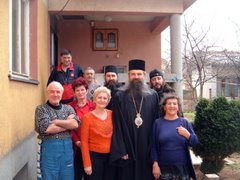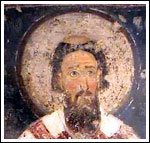Desecrations of Churches Sanctioned by Kosovar Goverment
August 18, 2008.
Source: Diocese of Ras-Prizren and Kosovo -Metohija
Communiqué of His Grace, Bishop of Raska-Prizren and Kosovo-Metohija, Artemije regarding the latest desecration of the Holy Trinity Church in Djakovica
A text, “Sharp Protest by Bishop Teodosije to the chairwoman of the Commission for the reconstruction of the Council of Europe and to the SRSG” appeared on the Serbian Orthodox Church website (written in Visoki Decani Monastery on July 12th 2008). Being mentioned in the text, in the sense of competence and authority, we issue, in the light of facts, a following assessment of such a “sharp protest” of vicar Bishop Teodosije.
In regard to annihilation of the foundations of Holy Trinity Church in Djakovica, the presented protest consists of information that “last year, within the preparatory works for the conservation of the foundations and fencing them off, garbage from the site was taken away, since the site was turned into an illegal garbage dump”.
We remind that exactly then, in September 2007, we made a reaction, as construction machines appeared on the site (Public communiqué of the Raska and Prizren Diocese from September 26th 2007 – Eradication of Serbian traces in Kosovo and Metohija continues).
We pointed out then that “last few days, construction machines clear away the remains of the devotional church of Liberty”, we warned that “voices are heard, claiming that Djakovica municipal structures intend to alienate the plot of land, where the temple was erected, from the Diocese of Raska and Prizren, and make it a cadastral register of Djakovica Municipality”. Particularly, we indicated that “under the auspices of the international community in the last eight years, the Albanians perpetrate spiritual and national genocide against the Serb people”.
We also remind on the reaction of the Council for church reconstruction and construction of Raska and Prizren Diocese, which, under our chairmanship, warned: “It is an alarming fact that on one of the locations in Djakovica, which is under reconstruction according to the Memorandum, last traces of Holy Trinity Church undergo their final destruction by the Albanian terrorists. This church was destroyed in 1999, devastated again in March 2004, and desecrated today, in the “reconstruction” process (Council’s Media communiqué – Disagreement with the Memorandum, from October 3rd, 2007).
We remind, too, on previous statements, untrue and harmful, made by Commission for reconstruction, concerning the ownership of this site: “the location is politically disputed and the ownership is under dispute” (Commission for the reconstruction report, 2006), as well as on our reaction: “through its report, the Commission officially misinforms about the ownership dispute, the site is in the ownership of the Serbian Orthodox Church”. (The Truth about reconstruction – a report presented to the Ambassadors of Security Council, in April 2007).
Hence, on numerous occasions, we lodged, as the Diocesan Bishop, a sharp protest over the treatment of this site, both to the representatives of The Church and The State.
A year later, Minister of culture in the role of arbiter
The then Minister of Culture in the Government of Republic of Serbia, Vojislav Brajovic, sent us a letter regarding the church in Djakovica, informing on the oral agreement between Bishop Teodosije and UNMIK, concerning garbage cleaning from the site (the letter No. 06-00-163/207-01 from October 9th 2007).
“In the period between 2004 and 2007, the local Albanians were disposing garbage on the place of previous church location, which additionally desecrated the place where the church was situated. Commission for reconstruction of churches destroyed in the March pogrom in Kosovo and Metohija inserted this church in the list of churches planned for reconstruction… The UNMIK representatives also complained to the Commission’s representative of the Serbian Orthodox Church about the impossible state in which the site of the previous church was, and therefore the Serbian Orthodox Church representative, Bishop Teodosije, orally agreed with UNMIK proposal that the garbage be cleared away from the site, without carrying out any other works at the same time, or clearing away the church foundations. UNMIK representative, Mr. Reiner, vouched to stick to the agreement on garbage disposal and that nothing else would be done apart. Simultaneously, an initiative was started within the Commission for reconstruction, that, as the first phase of reconstruction of the destroyed church, the site of the church be protected by fencing it off by high panels, in order to stop further garbage disposal on the same place.
Unfortunately, a construction machine (caterpillar) used during garbage disposal from the site where the church was, also cleared off the debris from the destroyed temple. As far as we know, the machines were not used to dig out the remains of the church foundations. UNMIK representatives did not completely stick to the framework of the agreed work, since they used construction machine without any particular need. Bishop Teodosije immediately demanded from UNMIK to stop any further works, which was done momentarily. At the same time, it was requested that the experts from the Commission for reconstruction visit the site as soon as possible to determine the state of facts”.
Which questions were opened by the arbiter?
How is it possible that the works according to the Memorandum start and are carried out on the site merely upon the oral agreement (vicar Bishop Teodosije “orally agreed” with clearing off the garbage upon UNMIK suggestion, he orally communicated “without carrying on any other works at the same time, or clearing away the church foundations”)?
If Bishop Teodosije, as member of the Commission orally agreed the works, who, on behalf of the Commission, monitored these works, especially having in mind that it is church foundations that are on the site?
We learn that UNMIK representatives “did not completely stick to the framework of the agreed work”, but we do not understand who established “the framework”, according to which procedure, under which conditions, when?
Who demanded, and on whose behalf “it was requested that the experts from the Commission for reconstruction visit the site as soon as possible to determine the state of facts” (Minister’s letter)?
Did the experts from the Commission for reconstruction visit the location?
Did the Commission experts determine the state of facts?
Which activities did the Commission carry out on the site, ten months since clearing away garbage (September 2007-July 2008)?
Why the official Report in 2007 from the Commission for Reconstruction noticed no activities on church site in Djakovica – “last year, within preparatory works for the foundation conservation and fencing the site off, garbage disposal from the site was carried out” (Serbian Orthodox Church web site), but it is only made public in July 2008?
Did the Commission’s inactivity on the site had as a goal further elongation of the reconstruction of the Church in Djakovica?
Continual elongation of the reconstruction of Holy Trinity Church in Djakovica
Bishop Teodosije formed the attitude of prolonging the reconstruction of the church already in the beginning of Memorandum implementation, accepting the UNMIK and Interim Kosovo Government’s point of view:
“The Church of Holy Trinity in Djakovica, because of an extremely complicated security situation in Djakovica, is perceived, not only by Kosovo Government, but also by UNMIK as a serious political issue. Our opinion is that priority is reconstruction of Dormition of the Theotokos church in Djakovica, as well as of churches in Bistrazhin and Piskote, while the site in the centre of the town could be fenced off and protected until more favourable conditions are met for the reconstruction of Holy Trinity Church”. (Report on the first trimester work of the Commission for Reconstruction, August 21st 2005, vicar Bishop Teodosije).
Agreement on the elongation was expressed in 2006, too:
“Three objects in the zone of Djakovica Municipality (The Holy Trinity Cathedral, completely destroyed, its ruins taken away, the church of St. Elias in Bistrazhin and the chapel of St. Lazarus in Piskote) are enlisted in a special category of objects whose reconstruction will start only when necessary security conditions, which at the time are very bad in the municipality, are created” (The Report on the works of the Commission for reconstruction, 2006, Bishop Teodosije).
In March 2007, vicar Bishop Teodosije comes forth with a proposal:
“As far as Holy Trinity Cathedral in Djakovica is concerned, it is an object which should be completely reconstructed, most probably within the framework of wider and more comprising programme of reconstruction of all other objects of the Serbian Orthodox Church destroyed in 1999. This programme should be established after the completion of reconstruction of the objects destroyed in March 2004 pogrom”. (The overview of programme for objects planned for reconstruction, March 2007).
Aren’t all the presented statements a direct contradiction to the information which Bishop Teodosije gave in beginning of May 2008 to the Holy Archieratical Synod:
“During reconstruction process the Commission for the reconstruction came to a conclusion that only through constant motivation of all sides included in reconstruction and in expert cooperation on multiethnic basis, the best results can be achieved. The reconstruction process is a process which does not have political character, and has as a goal reconstruction of Serbian cultural heritage, destroyed or damaged, primarily in the parts of Kosovo inhabited mainly by Albanians, in experts’ cooperation, feasible, as a very important segment in stimulating returns and renewal of liturgical life” (Report on the works of Commission for reconstruction, 2007, Bishop Teodosije).
Did the information on “expert cooperation on multiethnic basis”, on “reconstruction process is a process which does not have political character”, on the fact that Serb heritage is durable and feasible “primarily in the parts of Kosovo inhabited mainly by Albanians” misinform both the Holy Archieratical Synod and the Holy Archieratical Council of the Serbian Orthodox Church as well as the public, just as Djakovica example confirms it?
It is clear who prolongs the reconstruction of the church in Djakovica!
It is clear who supports the prolongation of the activities on the location!
Until when the reconstruction is prolonged? “…Until necessary favourable conditions for the reconstruction of the church are met”.
Who is the arbiter that assesses that these “favourable conditions” are met?
According to which procedure this assessment will be made?
According to which procedure and who will appoint the arbiter?
Why the reconstruction of the church is prolonged for the programme “which yet has to be established”?
Why the reconstruction of the church is suggested “after the completion of reconstruction of the objects destroyed in March pogrom 2004?
Does it mean that the location is exempted from the Memorandum?
Why Vicar Bishop Teodosije engages so much in prolongation and in whose favour?
The Question of Responsibility
Who, after all, bears the responsibility for shortcomings in regard to the preservation of the Serbian cultural heritage in Kosovo and Metohija? Surely those who, contrary to canonical regulations, interfering in our competence and authority, forcefully maintained the implementation of the Memorandum. A disastrous activity on annihilation of the location by the Albanians and the prolongation of the reconstruction of the Serb temple in Djakovica, above all with consent of Serbian side (as well as prolongation and exempting other location from Memorandum) are just a few from the bitter fruits of such a reconstruction process.
Thus, we pose a question about the responsibility for lawlessly insisting on the continuation of the reconstruction process according to Memorandum;
The responsibility for taking away from us, as lawful diocesan Bishop, the right to decide on the matters of reconstruction of sanctuaries in our Diocese;
The responsibility for not accepting our request, as the diocesan Bishop on determining new principles of reconstruction, i.e. the responsibility for the consequences of continuation of such a reconstruction, even after an argument-based and official indication on numerous flaws and inconceivable consequences;
The responsibility for enabling the Interim institution of self-government in Kosovo to fulfill the standard set for this area, standard VI;
The responsibility for supporting Council of Europe and Albanian institutions in their efforts to make the mechanism of “cooperation”, which came out of the Memorandum, grow into permanent model of institutional framework for protection of Serbian cultural heritage in Kosovo and Metohija;
The responsibility for enabling Albanian side to achieve references to work on the reconstruction of Serbian cultural heritage. Such references they could not have achieved without approval of the Serbian church, what UNMIK representative reminds us on, too: “The Albanian companies work on the restoration of the Serbian Church. It was decided by the Serbian Orthodox Church and hence I believe that everything is possible” (statement made by Fedor Klimchuk, Public debate on the work of Ministry for Culture, Youth and Sport, November 30th 2007);
The responsibility for entering into reconstruction process before assessment of damage inflicted during vandalisms, i.e. responsibility for annihilation of proofs on the inflicted damage;
The responsibility for destruction of the Serbian cultural heritage fund in the process of reconstruction by leaving out the indispensable construction phases and drifting from established regulations and standards;
The responsibility for stability of the objects, especially in case of earthquakes, due to disrespect of construction regulation in seismic zones and the responsibility for the people using those objects;
The responsibility for accepting the archaeological strategy as directive coming from the session of UNESCO and Council of Europe working group, held in 2005 in Paris;
The responsibility of turning the reconstruction into “mediation between differences”, for turning Serbian land into multiethnic Kosovo with no Serbs (250 000 expelled, out of which 207 000 internally displaced persons who still wait to return to their homes; violation of human rights and limited liberty of movement for members of ethnically discriminated communities; low profile terror directed towards members of ethnically discriminated communities, their property, cultural and religious heritage);
The responsibility for depriving Serb institutions of full responsibility for the care over Serbian cultural heritage in Kosovo and Metohija;
The responsibility for alienating the Serbian people as a whole from its spiritual and cultural heritage;
On and on, endlessly…
Bishop of Raska-Prizren
And Kosovo-Metohija
+ARTEMIJE

















